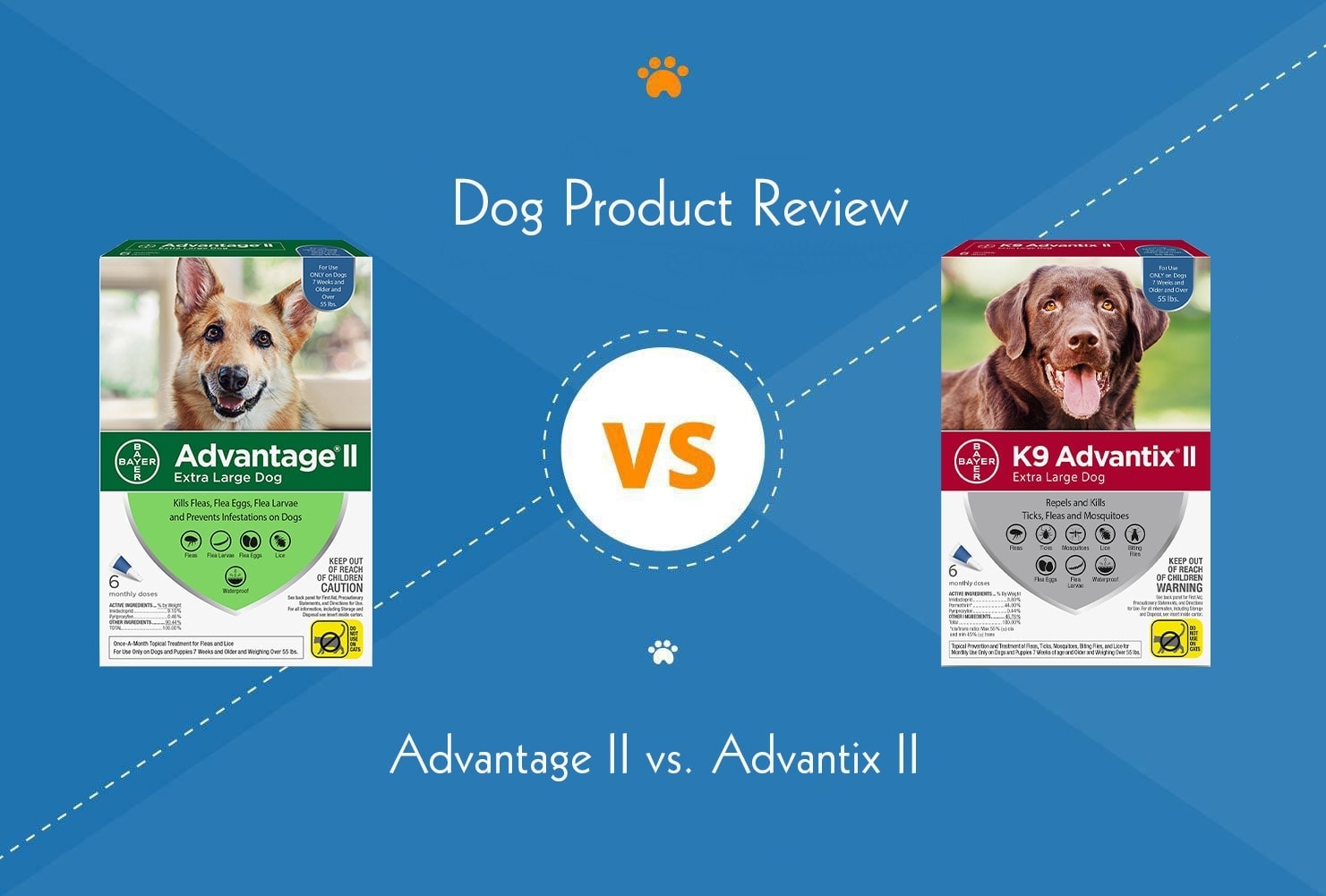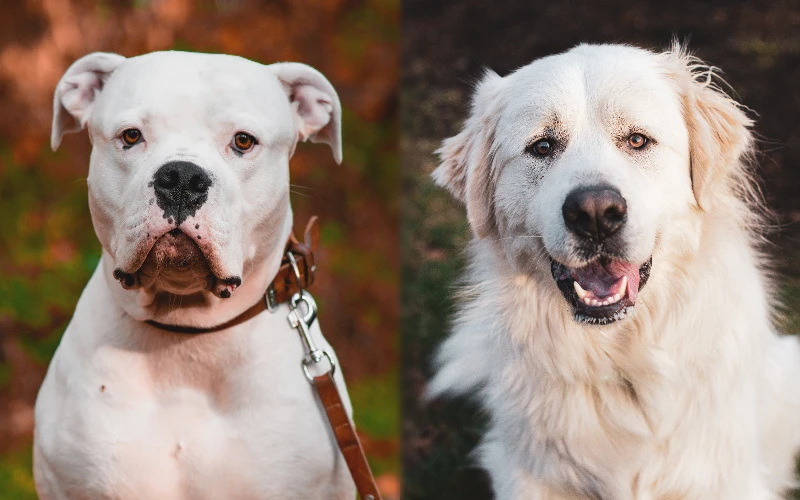Can Dogs Eat Radishes? Vet-Reviewed Facts & Suggestions

Updated on
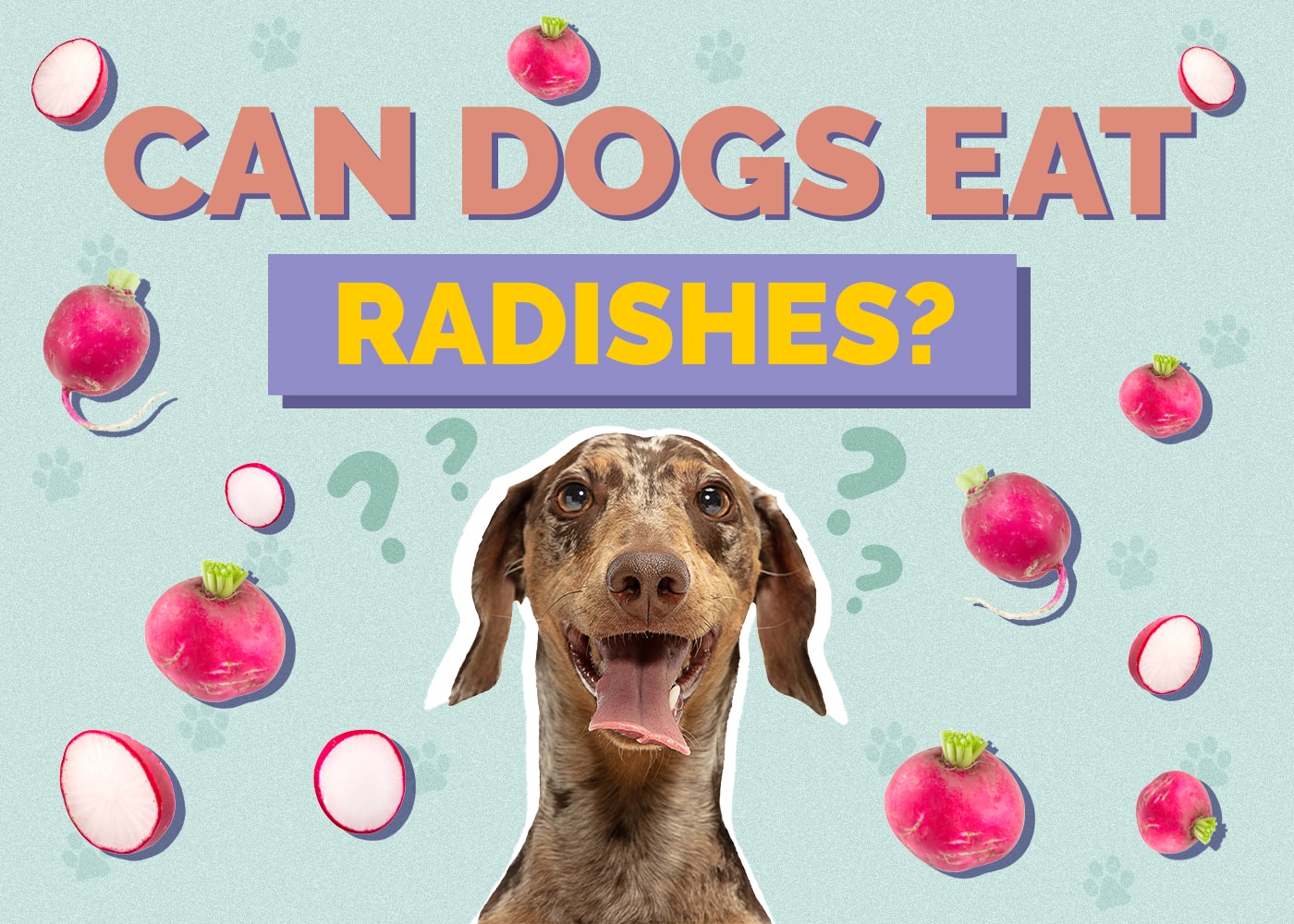
Some dog owners prefer to feed strictly-kibble diets, while others swear by home cooked meals with fish and meat. In any case, to keep our furry buds well-fed and healthy, the food needs to be rich in nutrients. That’s why animal docs often recommend mixing things up with crops and vegetables. For example, radishes have a high nutritional value and can be a great treat for pups.
As long as you keep the portions small and remove the leaves, radishes will supply the doggo with vitamin C, calcium, fiber, and other nutrients. So, how often should these veggies be included in the dog’s diet? Will you have to cook the radishes or serve them raw? Which varieties are most beneficial for dogs? Time to find out!
Spicy and Crunchy: A Quick Look at Radishes
So, what is a radish? This term describes a wide range of root vegetables from the Brassicaceae family. While the flesh is always white or light-colored, the skin color varies depending on various factors. It can be yellow, white, red, pink, purple, or even black. Radishes come in all shapes and sizes, but the most common ones are short, round, and red-skinned.
These vegetables are crunchy and have a spicy taste that can sometimes be a bit peppery. Radishes are a mighty source of nutrients and help reduce the risk of diabetes, lower blood pressure, and detoxify the liver, among other things. And dogs can benefit greatly from regularly munching on radishes.
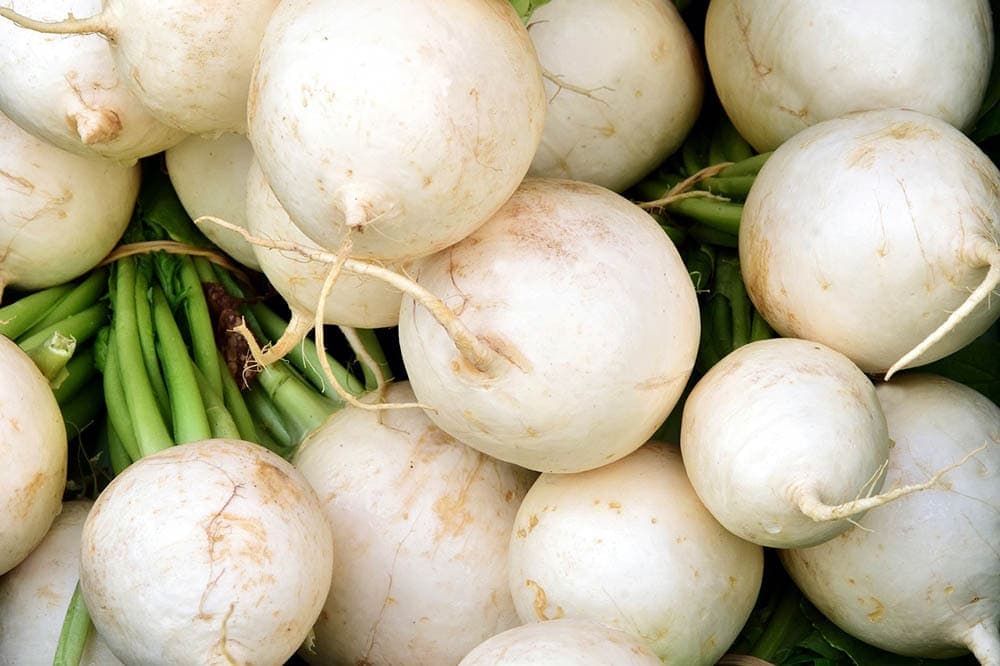
Should a Dog’s Diet Include Radishes?
Radish is a low-calorie, low-carbohydrate vegetable rich in fiber that does a great job of “boosting” the digestive system. It’s also high in calcium, an essential mineral for proper bone development, strong teeth, and overall good health. As for vitamin C (which radishes have plenty of), it serves as a powerful antioxidant for the doggo.
By fighting the free radicals in the body, vitamin C lowers the risk of cancer. On top of that, this vegetable contains high levels of iron, magnesium, potassium, and other important minerals. For example, potassium is vital for the dog’s muscles and heart. Lastly, the rough texture of the radish keeps the dog’s breath fresh by breaking down the plaque on its teeth.
Are Radishes Safe for Dogs to Eat?
The short answer is yes! Radishes are safe for pups to eat. With that, do remember that less is more. If you keep the portions small, the dog will get its share of nutrients from this vitamin-packed food and avoid potential side effects. Eating too much might upset the pup’s stomach, make it gassy, or cause diarrhea.
It is important to note that you should NEVER let the dog eat the greens, as they are known to cause gastroenteritis.
Radishes are also hydrating vegetables and serve as an excellent treat on a hot summer day. Next, the fiber in radishes is great news for the GI tract. So, if your dog is suffering from diarrhea or constipation, a little bit of this “magic food” might be able to solve the problem.

Can My Dog Be Allergic to This Vegetable?
Most canines won’t have any issues with the radish unless you feed them too much. However, a very small percentage of dogs might be allergic to it. Again, this is a non-toxic vegetable, but you should still watch the pet closely for any allergic symptoms and side effects. Start by feeding it tiny portions to keep the risks to a minimum. Anaphylactic reactions are very rare in dogs, with food allergies or intolerances largely presenting with itchy skin or gastrointestinal issues.
Also, consult with your veterinarian to make sure this food is safe for your pooch. Animal doctors can run an allergy test/panel to determine which products or foods the pet is hypersensitive toward. And here are the most common signs of a dog’s allergic reaction/intolerance to radishes:
- An upset stomach or nausea
- Diarrhea and vomiting
- Hot spots on the skin/itching
- Obsessive self-licking
- Pain or discomfort in the abdomen
- Lethargy or lack of daily activity
Which Radishes Are Good for Dogs?
The white radishes (the daikon radishes) are the better pick, as they’re not as spicy as the dark/black ones. They’re also more popular with people, which means you won’t have a hard time finding this nutritious vegetable at local grocery stores. Once you bring them home, don’t forget to cut out the leaves to protect the pet’s stomach. Remove the outer skin with a veggie peeler, then cut the radish into tiny pieces.
When ordering online, make sure you’re not getting a pack of wild radishes, as they are not the same thing. Wild radish is a flowering plant that’s edible but harmful to canines. The same goes for the horseradish. It’s known to upset the stomach and gastrointestinal tract of most dog breeds. This is because it’s much spicier than the toughest radish and can irritate both the tongue and the eyes, causing tears.
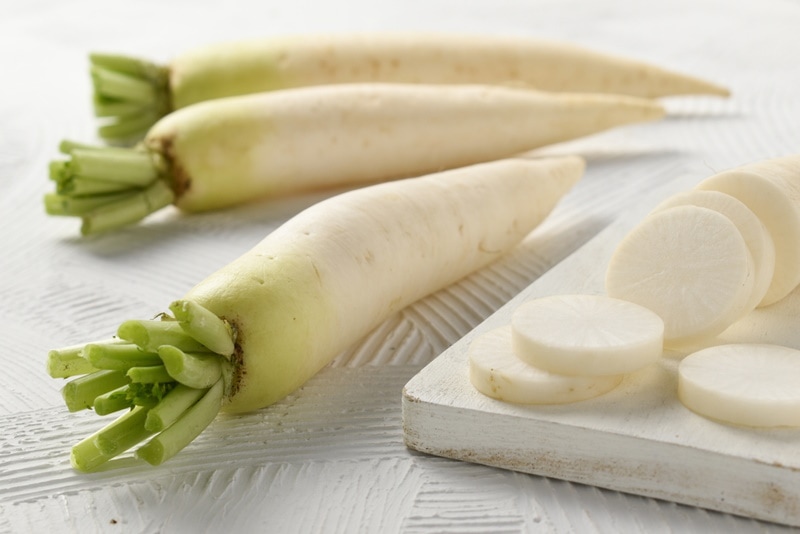
How Many Radishes Can Canines Eat? How Often?
There are no strict rules on this, as radishes are widely recognized as a safe food for dogs. For starters, chop an average-sized radish into smaller pieces (to avoid choking) and put them on the furry bud’s plate. If it takes more than one bite, that’s great news! But don’t overdo it; otherwise, the pet might lose its interest.
Once in two weeks is a good place to start. Again, see that the radish bits are small enough for the dog to chew on and swallow and try to “mask” the distinctive flavor with other ingredients. This way, the pooch might not even realize that you’ve added something new to its regular diet. But don’t be pushy; if the dog doesn’t like radishes, that means it’s simply not meant to be!
Raw vs Cooked Radish: The Benefits
Radishes are an acquired taste. So, while they might not appeal to your furry champ in their raw form, a roasted radish could be an entirely different story. And the reason for that is simple: when roasted, these peppery veggies lose some of that spicy “edge” and become a bit softer. As a result, the dog will be happier to munch on this superfood.
More than that, cooked radishes are easier to mix with other ingredients. The same is true for a wide range of vegetables, especially the ones that take a little bit of effort to chew through. Be aware that cooking will invariably reduce the nutritional value of the vegetable, so do not overdo it. Steaming the vegetables is a great way to get the benefits of cooking whilst retaining a lot of their value.
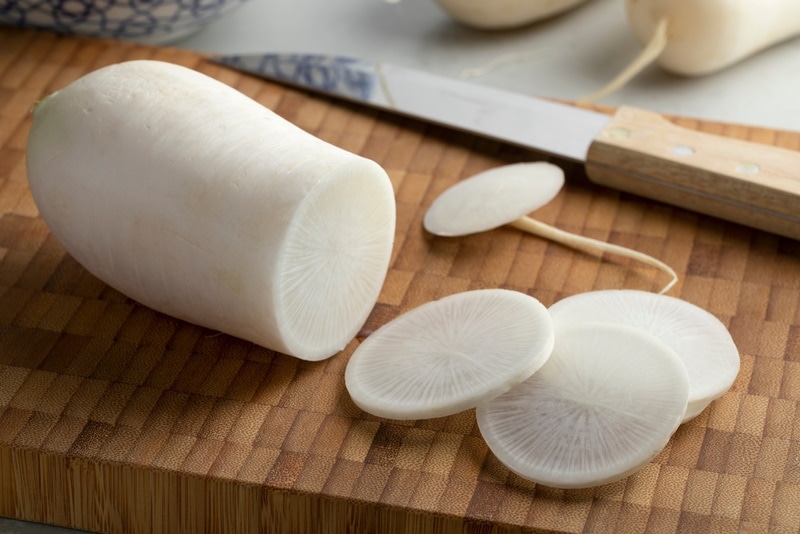
The Best Alternatives to Radishes: Breaking It Down
What if your furry friend refuses to jump on board with the wonders of the radish? Don’t worry, there are quite a few dog-friendly vegetables out there that can replace (or complement) this spicy produce. Pumpkin or sweet potatoes offer great digestive benefits and are often more palatable. The list of dog-safe vegetables also includes carrots, cucumber, cauliflower, broccoli, cabbage; really, too many to mention!
Most of these foods are rich in vitamins A and C, fiber, calcium, and other essential nutrients. As always, wash the veggies properly, remove all the leaves and seeds, and feed them to the doggo in moderate portions. Be patient and see what “works” for your pet. Some dogs are big fans of carrots, while others like to chew on something leafy like celery or spinach.
What Veggies Should We Not Feed to Dogs?
Thankfully, the list of vegetables that can be harmful to a dog isn’t very big. For the most part, you should exclude onions, asparagus, and wild mushrooms from the diet, and that should do it. Just like garlic, chives, and leeks, onions are toxic to dogs. The side effects include diarrhea, nausea, and vomiting. In the worst-case scenario, onions can even lead to the rupture of the pup’s red blood cells.
This is especially true for breeds like Shiba Inus and Akitas. As for asparagus, it’s not a bad food for canines per se, but it’s not particularly beneficial, either. Raw asparagus is hard to chew on; when cooked, it loses nutritional value. Lastly, avoid any mushrooms you see on your next trip to the local park, forest, or your own backyard. If the doggo accidentally eats one, take it to a veterinarian ASAP (preferably with a sample of the mushroom itself).
Conclusion
If you’re on a mission to keep your dog strong and healthy, you might want to introduce it to radishes. While the pet probably won’t get very excited about it (the taste isn’t that great), we would still encourage you to give it a chance. Radishes are rich in vitamins, minerals, and fiber and can, indeed, boost the fur baby’s immune system.
The rules here are the same as with any other “exotic” treats: feed the radish moderately and let the dog decide whether it likes it or not. Chances are that the pet might enjoy the peppery taste. If so, radishes can turn into an occasional, yet essential treat for both of you!
You Might Also Be Interested In:



